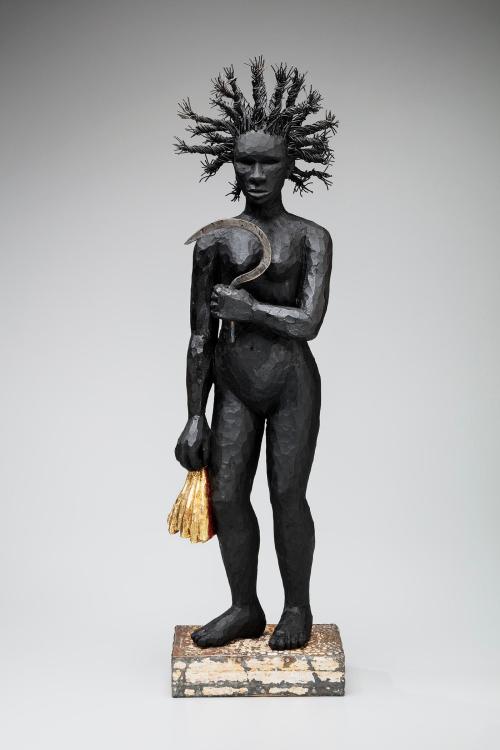Topsy and the Golden Fleece
Artist: Alison Saar (American, born 1956)
Date: 2017
Dimensions:
35 1/2 × 11 1/2 × 8 1/2 in. (90.2 × 29.2 × 21.6 cm)
Medium: wood, tar, steel, ceiling tin, wire, acrylic paint, and gold leaf
Classification: Sculpture
Credit Line: Purchased with funds from the Florence Scott Libbey Bequest in Memory of her Father, Maurice A. Scott
Object number: 2018.37
Label Text:Topsy and the Golden Fleece embodies multiple narratives surrounding race, gender, and empowerment. The artist Alison Saar alludes to the character Topsy, a young enslaved girl from Harriet Beecher Stowe’s problematic abolitionist novel Uncle Tom’s Cabin (1851), and also to the story of Jason and the Argonauts from Greek mythology. In Stowe’s novel, the dying Eva, daughter of the slave master, gives a lock of her golden hair to her playmate Topsy in an attempt to encourage the girl’s conversion to Christianity. Saar interprets Topsy not as the “wild” and vulnerable child of the book, but instead as a dark-skinned, defiant, and powerful adult. Rather than needing to be “saved” by the White, blonde Eva, Topsy is shown as a mythological hero—nude, holding a scythe, her braids encircling her head like a halo or a crown. She carries a golden bundle that suggests the legendary Golden Fleece, a symbol of kingship and authority that the Greek hero Jason had to obtain in order to take his place on the throne. The conflation of the two stories invites a compelling comparison between the Golden Fleece and Eva’s lock (head?) of golden hair.
DescriptionA woman brusquely carved from black wood stands on top of a rectangular slab base. In her left hand she holds a sickle close to her chest; in her right she holds a shining gold cloth-like material. Her hair of twisted wire stands upright in an electrified halo around her
head; her simply articulated face is stoic and withholding.
head; her simply articulated face is stoic and withholding.
Not on view







